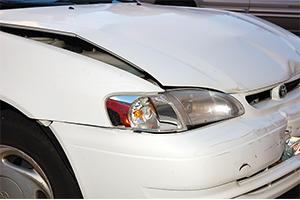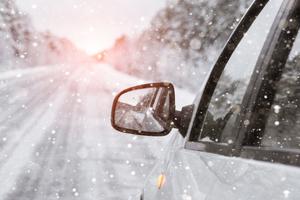Safe driving in rainy weather
Streaky windshields, night glare and pounding rain can considerably reduce a driver's ability to see. But that isn't the only challenge to be faced when driving in rainy weather. Wet roads may double the required stopping distance. During dry periods, a layer of residue builds up on the highway surface, and when it rains, the water floats it loose, forming a slick film on the road. Wet pavement, covered with road film or spotted with oil, grease and dirt, makes quick stops extremely difficult.
Perhaps the most serious factor affecting the ability to stop is tire hydroplaning.
Why hydroplaning occurs
As your vehicle rolls along on wet pavement a layer of water builds up ahead of the front tires. When the tire treads can no longer disperse this water, the wheels are lifted up in much the same way water lifts a skier.
The danger of hydroplaning is always present on wet or slushy roads. You can drive along for miles on the verge of a skid without being aware of it.
Hydroplaning occurs at virtually all speed ranges depending on conditions. As you increase the speed of your vehicle, the chances of hydroplaning become greater.
Below are some suggestions for driving safely in rainy weather.
- Slow down. Reduce your speed on wet roads. Beware of tire hydroplaning on high-speed expressways. You may lose ability to steer as well as your ability to brake. It can take a heavy rain a half-hour to wash away the oil slick and a lighter rain can take even longer.
- Allow extra distance for stopping. It takes your vehicle longer to stop when road surface conditions are less than optimal.
- Drive in the tracks of the vehicle in front of you. This can reduce the risk of hydroplaning due to contaminant dispersion.
- Check your wipers. Rubber wiper blades deteriorate when exposed to sun or temperature extremes. Six months is the average blade's effective life. If your blades won't wipe the windshield clean, have them replaced.
- Replace badly worn tires. Worn tires can increase hydroplaning potential, reduce traction control and prevent your vehicle from getting the best grip on the road surface.
- Drive with the tires inflated to the manufacturer's specifications. Tires perform best when properly inflated.
- Turn your lights on. With good wipers and defrosters you may see others, but can they see you? Use your low beams so you can be seen by pedestrians and other vehicles. Never drive with only your parking lights on.
- Watch surface conditions. Even though the rain has stopped, the streets may remain slippery. Traffic statistics indicate that high accident rates often continue for three to four hours after the rain stops.
- Beware of deep puddles. Check your braking ability immediately after driving through deep water. Some wet brakes will dry by repeatedly pumping the pedal or dragging your brakes for a moment or two when it is safe to do so.
This material is provided for informational purposes only and does not provide any coverage or guarantee loss prevention. The examples in this material are provided as hypothetical and for illustration purposes only. The Hanover Insurance Company and its affiliates and subsidiaries (“The Hanover”) specifically disclaim any warranty or representation that acceptance of any recommendations contained herein will make any premises, or operation safe or in compliance with any law or regulation. By providing this information to you. The Hanover does not assume (and specifically disclaims) any duty, undertaking or responsibility to you. The decision to accept or implement any recommendation(s) or advice contained in this material must be made by you.
LC DEC 2018 LC 11-389
171-1128 (10/14)
Related resources
Safe driving in rainy weather
Streaky windshields, night glare and pounding rain can considerably reduce a driver's ability to see. But that isn't the only challenge to be faced when driving in rainy weather. Wet roads may double the required stopping distance. During dry periods, a layer of residue builds up on the highway surface, and when it rains, the water floats it loose, forming a slick film on the road. Wet pavement, covered with road film or spotted with oil, grease and dirt, makes quick stops extremely difficult.
Perhaps the most serious factor affecting the ability to stop is tire hydroplaning.
Why hydroplaning occurs
As your vehicle rolls along on wet pavement a layer of water builds up ahead of the front tires. When the tire treads can no longer disperse this water, the wheels are lifted up in much the same way water lifts a skier.
The danger of hydroplaning is always present on wet or slushy roads. You can drive along for miles on the verge of a skid without being aware of it.
Hydroplaning occurs at virtually all speed ranges depending on conditions. As you increase the speed of your vehicle, the chances of hydroplaning become greater.
Below are some suggestions for driving safely in rainy weather.
- Slow down. Reduce your speed on wet roads. Beware of tire hydroplaning on high-speed expressways. You may lose ability to steer as well as your ability to brake. It can take a heavy rain a half-hour to wash away the oil slick and a lighter rain can take even longer.
- Allow extra distance for stopping. It takes your vehicle longer to stop when road surface conditions are less than optimal.
- Drive in the tracks of the vehicle in front of you. This can reduce the risk of hydroplaning due to contaminant dispersion.
- Check your wipers. Rubber wiper blades deteriorate when exposed to sun or temperature extremes. Six months is the average blade's effective life. If your blades won't wipe the windshield clean, have them replaced.
- Replace badly worn tires. Worn tires can increase hydroplaning potential, reduce traction control and prevent your vehicle from getting the best grip on the road surface.
- Drive with the tires inflated to the manufacturer's specifications. Tires perform best when properly inflated.
- Turn your lights on. With good wipers and defrosters you may see others, but can they see you? Use your low beams so you can be seen by pedestrians and other vehicles. Never drive with only your parking lights on.
- Watch surface conditions. Even though the rain has stopped, the streets may remain slippery. Traffic statistics indicate that high accident rates often continue for three to four hours after the rain stops.
- Beware of deep puddles. Check your braking ability immediately after driving through deep water. Some wet brakes will dry by repeatedly pumping the pedal or dragging your brakes for a moment or two when it is safe to do so.
This material is provided for informational purposes only and does not provide any coverage or guarantee loss prevention. The examples in this material are provided as hypothetical and for illustration purposes only. The Hanover Insurance Company and its affiliates and subsidiaries (“The Hanover”) specifically disclaim any warranty or representation that acceptance of any recommendations contained herein will make any premises, or operation safe or in compliance with any law or regulation. By providing this information to you. The Hanover does not assume (and specifically disclaims) any duty, undertaking or responsibility to you. The decision to accept or implement any recommendation(s) or advice contained in this material must be made by you.
LC DEC 2018 LC 11-389
171-1128 (10/14)
Related resources
Safe driving in rainy weather
Streaky windshields, night glare and pounding rain can considerably reduce a driver's ability to see. But that isn't the only challenge to be faced when driving in rainy weather. Wet roads may double the required stopping distance. During dry periods, a layer of residue builds up on the highway surface, and when it rains, the water floats it loose, forming a slick film on the road. Wet pavement, covered with road film or spotted with oil, grease and dirt, makes quick stops extremely difficult.
Perhaps the most serious factor affecting the ability to stop is tire hydroplaning.
Why hydroplaning occurs
As your vehicle rolls along on wet pavement a layer of water builds up ahead of the front tires. When the tire treads can no longer disperse this water, the wheels are lifted up in much the same way water lifts a skier.
The danger of hydroplaning is always present on wet or slushy roads. You can drive along for miles on the verge of a skid without being aware of it.
Hydroplaning occurs at virtually all speed ranges depending on conditions. As you increase the speed of your vehicle, the chances of hydroplaning become greater.
Below are some suggestions for driving safely in rainy weather.
- Slow down. Reduce your speed on wet roads. Beware of tire hydroplaning on high-speed expressways. You may lose ability to steer as well as your ability to brake. It can take a heavy rain a half-hour to wash away the oil slick and a lighter rain can take even longer.
- Allow extra distance for stopping. It takes your vehicle longer to stop when road surface conditions are less than optimal.
- Drive in the tracks of the vehicle in front of you. This can reduce the risk of hydroplaning due to contaminant dispersion.
- Check your wipers. Rubber wiper blades deteriorate when exposed to sun or temperature extremes. Six months is the average blade's effective life. If your blades won't wipe the windshield clean, have them replaced.
- Replace badly worn tires. Worn tires can increase hydroplaning potential, reduce traction control and prevent your vehicle from getting the best grip on the road surface.
- Drive with the tires inflated to the manufacturer's specifications. Tires perform best when properly inflated.
- Turn your lights on. With good wipers and defrosters you may see others, but can they see you? Use your low beams so you can be seen by pedestrians and other vehicles. Never drive with only your parking lights on.
- Watch surface conditions. Even though the rain has stopped, the streets may remain slippery. Traffic statistics indicate that high accident rates often continue for three to four hours after the rain stops.
- Beware of deep puddles. Check your braking ability immediately after driving through deep water. Some wet brakes will dry by repeatedly pumping the pedal or dragging your brakes for a moment or two when it is safe to do so.
This material is provided for informational purposes only and does not provide any coverage or guarantee loss prevention. The examples in this material are provided as hypothetical and for illustration purposes only. The Hanover Insurance Company and its affiliates and subsidiaries (“The Hanover”) specifically disclaim any warranty or representation that acceptance of any recommendations contained herein will make any premises, or operation safe or in compliance with any law or regulation. By providing this information to you. The Hanover does not assume (and specifically disclaims) any duty, undertaking or responsibility to you. The decision to accept or implement any recommendation(s) or advice contained in this material must be made by you.
LC DEC 2018 LC 11-389
171-1128 (10/14)
Related resources
Safe driving in rainy weather
Streaky windshields, night glare and pounding rain can considerably reduce a driver's ability to see. But that isn't the only challenge to be faced when driving in rainy weather. Wet roads may double the required stopping distance. During dry periods, a layer of residue builds up on the highway surface, and when it rains, the water floats it loose, forming a slick film on the road. Wet pavement, covered with road film or spotted with oil, grease and dirt, makes quick stops extremely difficult.
Perhaps the most serious factor affecting the ability to stop is tire hydroplaning.
Why hydroplaning occurs
As your vehicle rolls along on wet pavement a layer of water builds up ahead of the front tires. When the tire treads can no longer disperse this water, the wheels are lifted up in much the same way water lifts a skier.
The danger of hydroplaning is always present on wet or slushy roads. You can drive along for miles on the verge of a skid without being aware of it.
Hydroplaning occurs at virtually all speed ranges depending on conditions. As you increase the speed of your vehicle, the chances of hydroplaning become greater.
Below are some suggestions for driving safely in rainy weather.
- Slow down. Reduce your speed on wet roads. Beware of tire hydroplaning on high-speed expressways. You may lose ability to steer as well as your ability to brake. It can take a heavy rain a half-hour to wash away the oil slick and a lighter rain can take even longer.
- Allow extra distance for stopping. It takes your vehicle longer to stop when road surface conditions are less than optimal.
- Drive in the tracks of the vehicle in front of you. This can reduce the risk of hydroplaning due to contaminant dispersion.
- Check your wipers. Rubber wiper blades deteriorate when exposed to sun or temperature extremes. Six months is the average blade's effective life. If your blades won't wipe the windshield clean, have them replaced.
- Replace badly worn tires. Worn tires can increase hydroplaning potential, reduce traction control and prevent your vehicle from getting the best grip on the road surface.
- Drive with the tires inflated to the manufacturer's specifications. Tires perform best when properly inflated.
- Turn your lights on. With good wipers and defrosters you may see others, but can they see you? Use your low beams so you can be seen by pedestrians and other vehicles. Never drive with only your parking lights on.
- Watch surface conditions. Even though the rain has stopped, the streets may remain slippery. Traffic statistics indicate that high accident rates often continue for three to four hours after the rain stops.
- Beware of deep puddles. Check your braking ability immediately after driving through deep water. Some wet brakes will dry by repeatedly pumping the pedal or dragging your brakes for a moment or two when it is safe to do so.
This material is provided for informational purposes only and does not provide any coverage or guarantee loss prevention. The examples in this material are provided as hypothetical and for illustration purposes only. The Hanover Insurance Company and its affiliates and subsidiaries (“The Hanover”) specifically disclaim any warranty or representation that acceptance of any recommendations contained herein will make any premises, or operation safe or in compliance with any law or regulation. By providing this information to you. The Hanover does not assume (and specifically disclaims) any duty, undertaking or responsibility to you. The decision to accept or implement any recommendation(s) or advice contained in this material must be made by you.
LC DEC 2018 LC 11-389
171-1128 (10/14)





